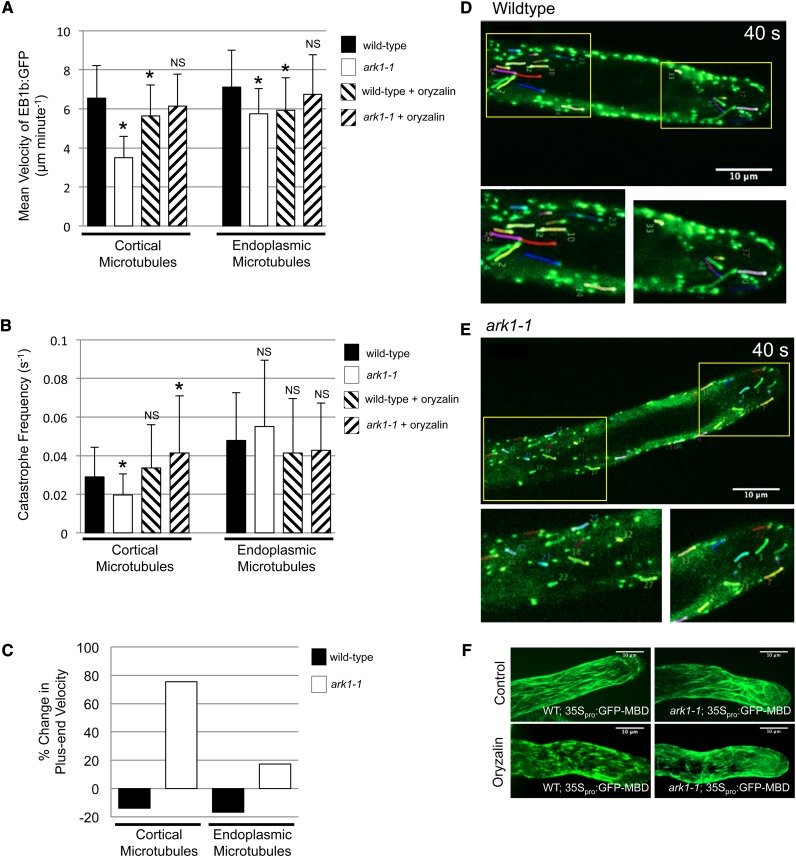Figure 1.
Cortical Microtubule Plus-End Velocities and Catastrophe Frequencies Are Reduced in ark1-1 Root Hairs but Can Be Rescued by Oryzalin Treatment.
(A) Plus-end velocities of EB1b-GFP of CMTs and EMTs were measured in wild-type and ark1-1 elongating root hairs upon imaging with spinning-disc confocal microscopy. The mean ark1-1 microtubule plus-end velocities (CMT, 3.5 ± 1.1 μm/min, n = 111; EMT, 5.7 ± 1.3 μm/min, n = 85) are significantly reduced relative to wild-type microtubules (CMT, 6.5 ± 1.7 μm/min, n = 209; EMT, 7.1 ± 1.9, n = 149). Exposure to 100 nM oryzalin rescued the microtubule plus-end velocities of ark1-1 root hairs (CMT, 6.1 ± 1.6 μm/min, n = 47; EMT, 6.7 ± 2.0 μm/min, n = 106) so that there was no significant difference from oryzalin-free wild-type root hairs (CMT, 6.5 ± 1.7 μm/min, n = 209; EMT, 7.1 ± 1.9 μm/min, n = 149). Oryzalin treatment significantly reduced wild-type velocities (CMT, 5.6 ± 1.6 μm/min, n = 134; EMT, 5.9 ± 1.7 μm/min, n = 76). A minimum of five roots (for untreated) and three roots (for oryzalin-treated) (five root hairs per root) from each genetic background were imaged.
(B) Catastrophe frequencies of cortical and endoplasmic microtubules were measured in the same elongating root hairs as in (A). Cortical microtubule catastrophe frequencies in ark1-1 (0.020 ± 0.011 events/second) are significantly reduced relative to wild-type microtubules (0.029 ± 0.015 events/second). There is no significant difference for endoplasmic microtubules (wild type, 0.048 ± 0.025 events/second; ark1-1, 0.055 ± 0.034 events/second). Exposure to 100 nM oryzalin increased the catastrophe frequency of cortical microtubules in ark1-1 root hairs (0.041 ± 0.03 events/second) relative to untreated wild-type root hairs (0.029 ± 0.015 events/second). The same microtubules in (A) were used to calculate the catastrophe frequency.
(C) Exposure to 100 nM oryzalin reduced microtubule plus-end velocities in wild-type root hairs but increased velocities in ark1-1 root hairs.
(D) and (E) Confocal micrographs of EB1b-GFP in wild-type (D) and ark1-1 (E) root hairs showing both cortical and endoplasmic microtubule plus ends. The colored lines represent the EB1b-GFP trajectories after 40 s with the wild type showing faster EB1b-GFP movement than ark1-1. Images represent the medial plane of the root hair. Magnified images of the trajectories are seen below and the yellow boxes indicate the area where the magnified images were selected. For the full montage, refer to Supplemental Figure 1. Images are representations of Supplemental Movies 1 and 2 online. Bars =10 μm.
(F) Spinning-disc laser confocal micrographs of root hairs expressing the 35Spro:GFP-MBD microtubule marker in the wild type and ark1-1. No differences were noticeable between the microtubules of wild-type and ark1-1 root hairs treated with 100 nM oryzalin. Images are merged Z-projections of the entire root hair stack.
Data and bars are represented as means ± sd, respectively. Asterisk shows a significant reduction, while NS indicates no significant difference in velocity relative to untreated wild-type root hairs using a two-sample t test with unequal variance (α = 0.01).

